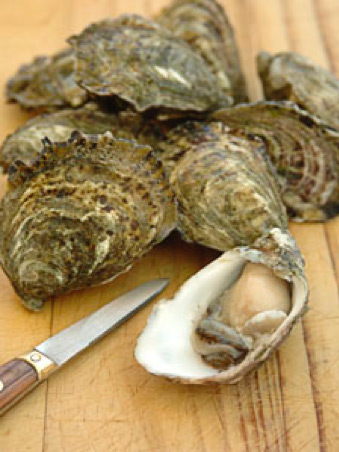Lamb stuffed with oysters
Lamb stuffed with oysters is, as Jane Grigson would say, an eighteenth century recipe and a good one, suitable for Easter dinner or any grand occasion. The marriage may appear unlikely to twentieth century sensibilities but the couple is remarkably congenial. Eliza Smith published a recipe in 1729 and the tradition still held sway with Eliza Acton over a century later. An easy dish to prepare despite its impressive impact. For six to eight.
 a boned and butterflied lamb leg of about 4-5 lb
a boned and butterflied lamb leg of about 4-5 lb
For the stuffing:
- a dozen or so oysters
- about 1 cup breadcrumbs
- 3 Tablespoons unsalted butter
- zest of ½ lemon
- ½ teaspoon mace
- 2 Tablespoons minced parsley
- an egg yolk or two
- some, usually about a Tablespoon, of the oyster liquor
For the sauce:
- ¾ cup oyster liquor
- ½ cup red wine, preferably Bordeaux, or Port, preferably tawny
- 2 or 3 minced anchovies-about 2 Tablespoons minced onion
- a few nutmeg gratings
- 6 or more minced oysters
- pan drippings from the lamb
Preheat the oven to 325˚.
- Dump all the ingredients into a food processor and blast them to a homogenous paste. Start with but a splash of the liquor and add more as required. You want a paste, not a slurry
- Smear the inside of the lamb with the stuffing; if any is leftover coat the top of the lamb with it after you roll and tie the leg.
- Roast the lamb on a rack until pink or more as you like, usually in about four or more hours, or until a meat thermometer hits 145-50.
- Start the sauce by simmering everything but the oysters together until the solids collapse, which take less time than roasting the meat.
- Once the lamb is done, finish the sauce while the meat rests a good 20 minutes by returning it to the heat, whisking the drippings from the pan into the sauce and then adding the oysters to cook them through.
Notes:
-“In this preparation,” as Miss Acton properly says of the stuffing in her peerless Modern Cookery for Private Families, “the flavour of the oysters should predominate.”
-Eighteenth century cooks also like to stuff lamb with crab; substitute at least a generous half pound for the oysters. It sounds about as strange, and tastes just as spectacular, as the oysters stuffing.
-Mrs. Smith uses a few anchovies instead of the zest, substitutes thyme and savory for the parsley and thickens the stuffing with mashed hard boiled instead of raw egg yolks, a widespread eighteenth century practice.
-The sauce is essentially hers.
-White wine never appears in the sauce recipes, but is less alien to most palates today.

